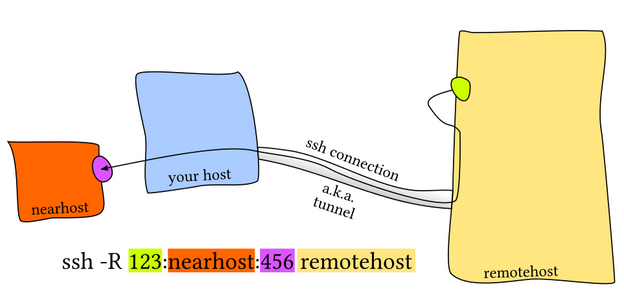
-M: Creates a direct tunnel on a port, loop-backed to a reverse one, echo_port.If we add authentication keys, as shown on our SSH keys tutorial, the tunnels will open without user intervention, as long as autossh is running. This utility can automatically create and recreate SSH sessions.
#Ssh reverse tunnel example software#
Even if we can even configure the frequency and timeout for the session keepalives to facilitate the connection-loss detections, it would be nice to fully automate the SSH session creation and reconnection.įor that, a handy piece of software is autossh. Persistent Tunnelsīy the way, an SSH tunnel only exists as long as the SSH connection holds. Also, the host specification allows wildcards. Reverse/callback tunnel on port 8022 in the loopback interfaces of the SSH server to our local client hostĪ lot of other options are available, like compression, Kerberos authentication forwarding, and many others.Direct tunneling from the local port 5432 to remote host 10.1.4.200 port 5432.This will connect to the remote SSH server on 10.1.4.100, using user ‘ baeldung‘, allowing: RemoteForward localhost:8022 localhost:22 In these files, we can specify default configurations to each commonly used endpoint, including forwarding tunnels and proxies: host 10.1.4.100 Command line Lets assume you are connecting to the as a user guest using a command ssh. Reverse SSH port forwarding will let you forward a port on the remote. Creating a reverse tunnel takes just one switch -R to the original command. If it doesn’t exist, which is the default, we’ll have to create a new one. Scenario: If you’re working from home, and you need access to your work computer that is behind your corporate firewall. We can use the global ssh client config file (located on /etc/ssh/ssh_config or/etc/openssh/ssh_config) or use our user’s specific configuration file that is located at ~/.ssh/config. The way we do that is, by using the standard command ssh -L port:addr:port addr with subprocess running in a separate thread. That’s why one of the most lovely features of ssh is allowing any command-line parameters in the config files. 16 At work we usually create ssh tunnels forwarding ports. If disabled, other hosts on the SSH server network might use it. The syntax here is very similar to local port forwarding, with a single change of -L for -R. We’ll tell SSH to make a tunnel that opens up a new port on the server, and connects it to a local port on your machine. X11UseLocalhost: Forces the X11 forwarding to be only allowed from the SSH server host loopback address. It can be any server on the internet, as long as you can connect to it.X11Forwarding: Specifies whether X11 forwarding is allowed.PermitTunnel: Specifies whether tun device forwarding is allowed.PermitOpen: Specifies the address and ports a TCP forwarding may point to.It provides more fine control if we enable GatewayPorts. PermitListen: Specifies the addresses and ports that can be bound to allow port-forwarding to clients.By default, only the hosts running the SSH server can use reverse tunnels. GatewayPorts: Allows other hosts to use the ports forwarded to a client (reverse tunnels).Override, if enabled, all other related configurations options DisableForwarding: Disables all kinds of forwarding.It enables single TCP port forwards and socks proxying AllowTcpForwarding: Allows TCP port forwarding.

AllowStreamLocalForwarding: Allows Unix domain sockets to be forwarded.Its location varies a little but is usually on /etc/ssh or /etc/openssh. It’s important to note that SSH tunneling is frequently used by hackers, who build backdoors in internal networks so that attackers can easily access internal data.The enablement of sshd, the daemon that serves ssh sessions, is done by editing the sshd_configfile. SSH keys use asymmetric encryption and provide an even higher level of security. SSH tunnels also offer increased security when you’re surfing on unfamiliar networks, for example in a hotel or coffee shop. A SSH File Transfer Protocol, SFTP for short, will be used for this.

If you’re transporting data from services that use an unencrypted protocol, you can use SSH forwarding to encrypt the data transfer.

This is similar to a Virtual Private Network (VPN) but is nonetheless different - try not to mix the two up. It will look like you are on this network, when you are in reality just accessing it using the SSH tunnel. The use of this virtual network allows certain restrictions on access to be bypassed. 10.0.0.12 is listening on port 4444 - it is ready to give a reverse shell to whoever joins. In most cases, SSH port forwarding is used to create an encrypted connection between a local computer (the local host) and a remote computer. There are various use cases for secure shell port forwarding. This procedure includes sample configuration commands for a user-supplied syslog server based on Ubuntu 14.04.5 LTS with rsyslog.


 0 kommentar(er)
0 kommentar(er)
